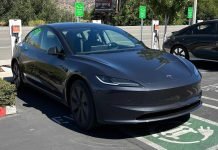There have several debates regarding the comparison between emissions of electric and combustion vehicles in recent times. Electric vehicles cut down on the constant carbon emissions of internal combustion engines using lithium-ion batteries and electric motors. However, the manufacturing of these batteries results in huge amounts of emissions through the factories, and after disposal, improper recycling causes a lot of harm to the planet. Many discussions have concluded that electric vehicles run on dirty electricity, and that electric mobility should be further decarbonized before being considered as a truly green means of transport. However, a recent study by the Eindhoven University of Technology points in the opposite direction.
Study Shows That Tesla Model 3 Emits 65% Less Lifetime Emissions Than Mercedes Benz C-Class
Auke Hoekstra and Prof. Maarten Steinbuch from the Automotive Technology department at the Eindhoven University of Technology (EUT) have mentioned in their study that past research has been wildly inaccurate, giving several mistakes that researchers have committed. After scrutinizing these mistakes and rectifying them through their own research, they have reached a conclusion. From the results, it is evident that electric vehicles can easily cut down on greenhouse gases and compensate for their manufacturing emissions through their lifetime. They have listed the mistakes made in the as well.
- Exaggerated emission figures of battery productions
Most of the studies claim that battery production emits 175 kg CO2 per kWh of battery, but these figures are exaggerated. This number is based on a highly controversial study in 2017, which was later corrected in 2019. It now states that the correct number is 82 kg per kWh, which is a little over half of what is being used. Through a variety of studies, it has been found that the final figure of carbon emissions during the manufacturing of lithium-ion batteries is between 40 to 100 kg CO2 per kWh of battery.
- Underestimating battery lifetime
Another mistake that these studies have made is underestimating the life of lithium-ion cells in a battery. Proper studies show that modern battery cells can last up to 500,000 km, and this number can as high as 2 million km in exceptionally good conditions. Despite this, most studies claim that an EV battery will last only 150,000 km, as opposed to 300,000 km in a gasoline or diesel engine.
- Assuming electricity will not get cleaner over the years
Most of the researchers have not considered the growth of the battery technology industry, and while this makes life easier for them, the results are unrealistic. The electricity mix has changed dramatically over the last 20 years, and it is foolish to assume that it will not get better over the next 20 years.
- Use test results provided by manufacturers themselves
There is a political side to the results of these tests as well. Many of the auto manufacturers supply researchers with wrong numbers, and the researchers go ahead with these numbers without verifying them. The Worldwide harmonized Light vehicles Test Cycle (WLTC) is supposed to change this scenario, but the political angle remains, where companies choose their own agencies to carry out tests.
- Downplay fuel production emissions
Production of fossil fuels like gasoline and diesel emits a large amount of greenhouse gases as well, and these numbers are larger than previously estimated. In order to account for this, 30% of emissions in petrol engines and 24% of emissions in diesel engines should be added to tailpipe emissions.
- Ignore the larger system
From the view of the complete powertrain, electric vehicles can be up to four times more efficient than their combustion counterparts. If we abide the Paris agreement, the emissions produced during the manufacturing of batteries are almost equal to fuel production emissions, which means emissions during the actual driving must be compared. This is where electric vehicles take the lead over combustion vehicles, and the results are for everyone to be seen.
From this study, the team of researchers at EUT have proven that in a comparison between a Volkswagen eGolf and a Toyota Prius of similar specifications, the eGolf emits 54% less emissions (grams CO2 per km) over its lifetime. These savings compensate for the battery production emissions by the end of 28,000 km, which means that all the kilometers it covers after that are going to be greener. Similarly, a Tesla Model 3 emits 65% less emissions than a Mercedes C 220d, and it pays back for battery production in 30,000 km. The Porsche Taycan S emits 82% less emissions and covers up for the battery production in just 11,000 km.
These are staggering figures in favor of electric vehicles. Many may argue that developing nations still do not have a robust infrastructure in place to make the purchase of electric vehicles viable. But the statistics do show that the immediate impact of an electric vehicle on the environment is significantly lower than the internal combustion vehicles. Add to this the fact that companies like Tesla are taking extensive efforts to recycle the batteries and motors from used cars into the production of new ones, and these emission figures will go down even further. All in all, the progress of the electric mobility industry is making drastic changes to the current scenario, and it is taking the world towards a truly green future.


















